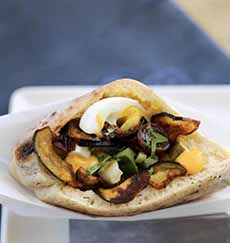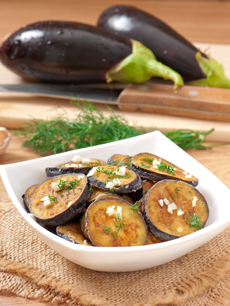Sabich Vegetarian Sandwich In Pita, A Recipe From Israel
|
|
Before we introduce sabich, a bit of background. First came hummus, seemingly from nowhere, to become a favorite American snack, spread and dip. Sixty years ago, hummus was little known in the U.S. We were fortunate to attend a university in Manhattan, home to international restaurants of every description. The neighborhood had both Greek and Mediterranean restaurants, so we were an early consumer of hummus, babaganoush, tahini, taramosalata, and other Mediterranean dips and spreads. (Here’s a list of those you can find in the U.S. today.) Note that some people call them dips, others call them spreads. Often they’re the same recipe. The nit-picking difference is that a spread is a food that is spread, typically with a knife, onto other foods, such as bread and crackers. Dips, on the other hand, have other food dipped into them. Thus, the same hummus “dip” can be spread onto a sandwich, or have raw vegetables, crackers and pretzels dipped into it. In 1986, a commercial hummus venture was launched in the U.S. by an Israeli immigrant. It was the Sabra brand. Soon enough, nutritionists advocated hummus as a better snack and spread, along with raw vegetables (crudités). Suddenly, everyday consumers nationwide were eating hummus. More brands proliferated, along with recipes for homemade hummus. Then came falafel. Throughout the 1960s and 1970s, it was found largely in immigrant communities. But in the last decades of the 1980s and 1990s, it began to establish itself as a mainstay of American cuisine [source]. And now, there’s sabich. It’s the second most popular sandwich in Israel, after falafel. Will it make its mark in the U.S.? As more people turn to vegetarian and vegan foods, sabich is primed for its moment. Sabich (pronounced with a hard ch) is a sandwich created in Israel by an Iraqi Jewish immigrant. The history of sabich is below. Sabich is a fusion of textures and flavors: soft and crunchy, creamy and crispy, tangy and a bit spicy. Instead of falafel’s fried balls of chickpeas with hummus and tahini sauce in pita, sabich, also a pita sandwich with hummus and tahini sauce, has different basic ingredients: You can also add grilled meat, poultry, or seafood. And you can add your spin; roasted red peppers and arugula instead of tomatoes and lettuce, for example. Here’s an example of extreme creativity: Photo #3 shows Green Chermoula Alaska Sole Sabich: a fish fillet a beet-pickled egg instead of the plain hard-boiled egg, chermoula sauce with harissa instead of hummus and tahini, and panko breadcrumbs for crispy eggplant slices. Here’s the recipe. But is it still sabich? We’d say that it’s an homage to sabich, and an example of how the classic version can inspire new concepts. |
|
|
THE HISTORY OF THE SABICH SANDWICH Ramat Gan, a town in the metropolitan Tel Aviv area, is considered to be the birthplace of sabich. In 1948, following increasing anti-Semitism in Iraq, a large number of Iraqi Jews fled to the newly-formed state of Israel. Many settled in the town of Ramat Gan. One particular refugee, Sabich Svi Halabi, settled in Ramat Gan. In the early 1960s, he bought a small food stand from an elderly couple. Among other offerings, he created a sandwich from the ingredients that were part of the Iraqi Jewish diet. The sabich sandwich†, as it became known, was a pita pocket stuffed with fried eggplant, hard-boiled eggs, hummus, tahini, tomato, cucumber and a mango sauce* called amba. He chose to use stuff an Israeli pita pocket rather than roll the ingredients in the traditional Iraqi flatbread, laffa (or lafa). It was more neatly handheld. European-styled pickles (pickled cucumbers) were also included. The concept spread: In the 1950s, street vendors throughout Israel began to sell sabich. Along with falafel, sabich became one of the most popular sandwiches in Israel [source]. It was eaten for breakfast and lunch, in casual restaurants and from street vendors. *Some sharp-eyed people question how mangoes became part of Israeli cuisine. Since medieval times, Iraqi Jewish merchants traded with India. Mango chutney was imported to Iraq, where locals of all faiths purchased it. Some Iraqi cooks enhanced the condiment with chiles, fenugreek and mustard. When the sabich was born, y Israeli pita rather than the traditional Iraqi flatbread; European-inspired cucumber pickles were thrown in too; and the Israeli passion for adding hummus to any sandwich was, of course, indulged. [source]. †You may also see a claim that “sabich” is an acronym for the Hebrew words for salad (salat), eggs (baytzim) and eggplant (chatizilim, with a hard ch). Modern Hebrew uses acronyms frequently, so some people like this explanation [source]. ‡Here’s a recipe to make amba from scratch. A hack is to buy mango chutney and season it with the ingredients in the recipe. Use the olive oil to give it more of a sauce consistency.
|
||






